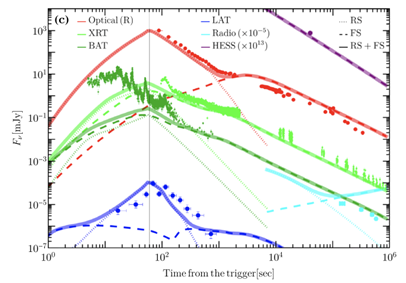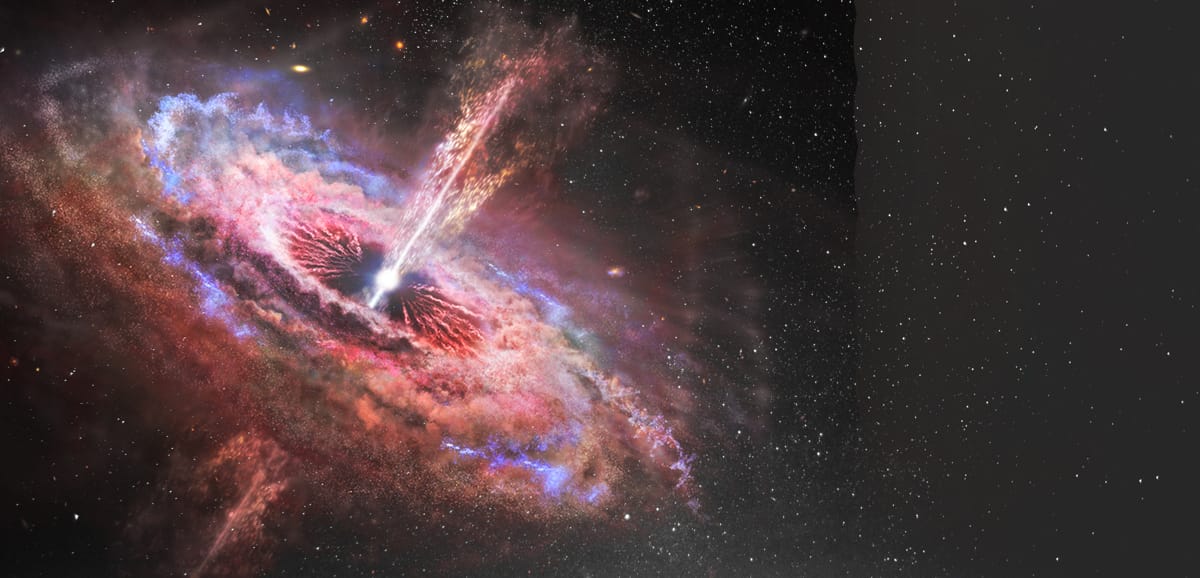Gamma-ray bursts (GRBs) are produced by ultra-relativistic jets that are slowed down by their interaction with the surrounding external medium. In the process, two shocks are launched – a forward shock that propagates ahead of the jet and shocks the swept up external medium, and a reverse shock that propagates into the jet, shocks the jet material and slows it down. These shocks accelerate electrons to relativistic energies and also generate in-situ or amplify weak pre-existing magnetic fields. The shock accelerated electrons then lose their energy by producing synchrotron photons that are observed as the broad band (from radio to gamma-rays) and long-lasting (over weeks, months, and years) afterglow emission.
The structure of the shock produced (likely behind the forward shock) and/or amplified (likely in the reverse shock) magnetic field is not clearly known. Some theoretical models and simple particle-in-cell numerical simulations propose that relativistic collisionless shocks in very weakly magnetized external medium produce small (particle skin-depth) scale magnetic fields, via a filamentation/Weible type instability, just behind the shock front and that this field is completely perpendicular to the shock normal (along the direction of the local velocity of the jet material). However, in a realistic GRB jet, as the shocked fluid propagates away from the shock front, the magnetic field is expected to be stretched out along the direction of the shock normal, thereby creating a perpendicular magnetic field component that dominates in large parts of the shocked material. This is expected to occur at the forward shock, but may not always be expected at the reverse shock. Depending on the composition and launching mechanism of the jet, both of which are highly uncertain at this point, it is possible that GRB jets are launched Poynting-flux dominated and contain a large-scale ordered toroidal magnetic field in the plane perpendicular to the jet motion (see schematic figure).
Figure: (a) The two shocked regions behind the forward (yellow) and reverse (green) shocks and the geometry of the magnetic field (blue lines). The forward shocked region contains a small-scale magnetic field stretched in the radial direction and the reverse shocked region contains a large-scale globally ordered toroidal magnetic field axisymmetric around the jet axis. The inset shows the stretching of field lines as the shocked material moves further downstream of the shock. (b) Polarization map (red ticks) and emissivity angular structure (colored gradient) of the reverse shock emission. The observer’s line-of-sight (red plus) is misaligned from the jet axis (blue plus). The observed emission is dominated by that arising from within the beaming cone (red circle), for which the net polarization angle is along the line connecting the jet axis to the line-of-sight. (c) Same as (b) but now showing the polarization map for the radially stretched

magnetic field seen here in projection. The net polarization angle is now perpendicular to that shown in (b).
Fortunately, the linear polarization signature of the afterglow synchrotron emission can be used to learn about the magnetic field structure in the two shocked regions. If the jet contains a large scale ordered magnetic field then the polarization of the reverse shock emission is expected to be much larger (up to few tens of percent) than that from the forward shock (up to only a few percent) as the latter contains small scale magnetic fields that are also axisymmetric around the observer’s line-of-sight. In addition, if the field is indeed stretched along the radial direction behind the forward shock, then the 90 degrees difference in the orientation of the two magnetic fields behind the forward and reverse shocks will likewise produce a 90 degree offset in the polarization angles of the synchrotron emission from the two shocked regions.
This 90 degrees offset in the polarization angle between the reverse and forward shock emissions was revealed for the very first time in a recent work published in the journal Nature Astronomy (https://www.nature.com/articles/s41550-023-02119-1), that involves two ARCO members (Ramandeep Gill and Jonathan Granot) who made important contributions to the theoretical interpretation and modeling of the observations. This inference was made possible by performing optical polarimetry of the afterglow emission of GRB 180720B from the early-time reverse-shock dominated phase (showing rapidly fading emission) to the late-time forward shock-dominated phase (see Figure).

Figure: (a) Optical afterglow lightcurve (red points) of GRB 180720B shown with that of two field stars (blue and yellow). (b) Polarization degree. (c) Polarization angle. The reverse shock emission dominates in the green shaded time interval and the forward shock emission dominates in the yellow shaded interval. The blue shaded interval shows a highly variable polarization evolution that may be attributed to turbulence in the shocked regions.
The optical emission was accompanied by GeV gamma-rays that were detected by the Fermi-LAT instrument in space. Remarkably, the GeV emission showed a lightcurve decay trend very similar to that of the optical when it was dominated by emission from the reverse shock, which indicated that both emissions were most likely coming from the same region of the flow obeying the same dynamical evolution. However, the GeV emission cannot be explained by the extension of the synchrotron component, that produced the optical emission, to higher energies. This is because the reverse shock emission here was produced after the reverse shock had already crossed and shocked all of the jet material, leaving no fresh electrons to be shock accelerated to high energies, thereby completely suppressing any GeV synchrotron emission.
One of the favored mechanisms to produce high energy emission from synchrotron-emitting relativistic electrons is inverse-Compton scattering by the same population of electrons in a process dubbed synchrotron self-Compton (SSC). Time-dependent spectral modeling that accounted for both synchrotron and SSC cooling of electrons in the two shocked regions confirmed the hypothesis, and also clearly demonstrated for the first time, that the GeV afterglow is simply the SSC emission from reverse-shock accelerated electrons (see figure

Figure: Broadband afterglow lightcurve of GRB 180720B and its modeling. Emission from both the reverse shock (dotted lines) and forward shock (dashed lines) is shown, accounting for both synchrotron and SSC cooling of shocked electrons. Both the optical and GeV emission before 1e3 sec is produced by reverse shock accelerated electrons after the shock has crossed the ejecta.
Both observations and their theoretical interpretations have important implications for the composition and launching mechanism of GRB jets as well as particle acceleration and radiative processes at collisionless relativistic shocks.





